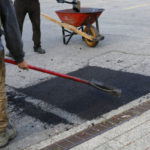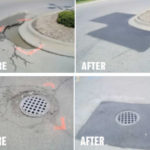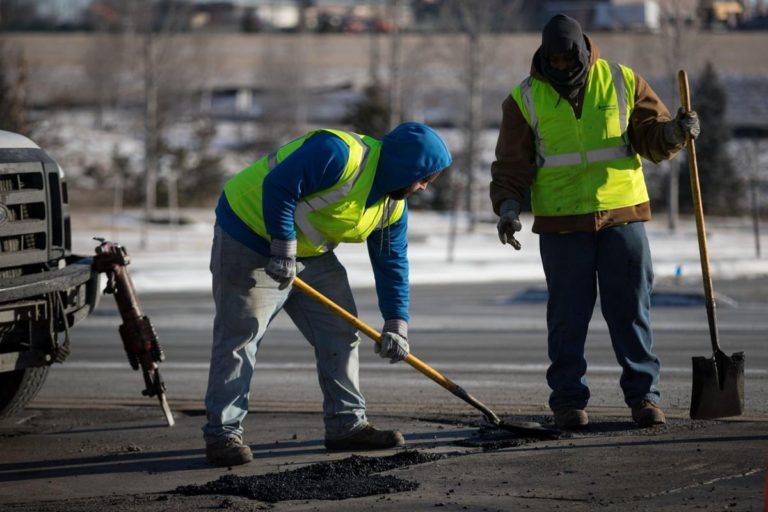You’re driving, and suddenly you hit a pothole. It’s jarring, it’s unexpected, and it can cause serious damage to your car. Potholes are a big problem, but they’re also something that we can plan to fix.
So, In this post, we’ll look at the danger of potholes, how they form, and how we can fix them so we can avoid costly repairs in the future.
The Dangers of Potholes
 Potholes are more than just an annoyance – they can be a serious safety hazard. They can cause damage to your car they can bend wheels, break suspension components, and pop tires. In severe cases, potholes can even cause accidents. So, it’s paramount to take an active role in preventing potholes from forming and taking action to repair them when they do.
Potholes are more than just an annoyance – they can be a serious safety hazard. They can cause damage to your car they can bend wheels, break suspension components, and pop tires. In severe cases, potholes can even cause accidents. So, it’s paramount to take an active role in preventing potholes from forming and taking action to repair them when they do.
How do they form?
 Potholes basically form when water seeps into cracks in the pavement, freezes, and then expands. This causes the pavement to break, forming a hole. Potholes can range in size from small craters to large depressions and can be found on any type of road or sidewalk. Furthermore, potholes can form anywhere, including in the middle of the road or in a parking lot.
Potholes basically form when water seeps into cracks in the pavement, freezes, and then expands. This causes the pavement to break, forming a hole. Potholes can range in size from small craters to large depressions and can be found on any type of road or sidewalk. Furthermore, potholes can form anywhere, including in the middle of the road or in a parking lot.
Who is responsible for pothole forming?
No single point can be given to this question. Potholes form due to a combination of factors, including: –
- The age and type of pavement that is in place: Yes, the age of the pavement matters.
- How much traffic passes over the road or sidewalk: Yes, the more traffic that passes over a road or sidewalk, the faster it will wear down.
- The material used in making the pavement: Yes, different materials have different durability levels.
- Climate conditions, such as rain and snowfall, can weaken pavement over time: No doubt that weather conditions can weaken the pavement over time. However, it is not clear how much of an effect climate has on pothole formation.
How to Fix a Pothole?
It is important to fix pothole repair as soon as possible to avoid further damage to the road. So how do you fix a pothole? There are several options for fixing potholes, including patching, milling, and resurfacing.
- Patching: Patching is the most common method of repairing potholes. This involves applying a mixture of asphalt and stone to fill in the hole. The patch will last for about five years and should be placed at least one foot away from any pavement cracks or joints.
- Milling: Milling involves grinding down the top layer of asphalt, removing any debris and loose material that may have fallen into the hole from above. The surface is then regraded to make it level again, and a new layer of asphalt is laid down.
- Resurfacing: Resurfacing is the most expensive option, but it’s also the most effective. This process involves removing all existing asphalt and adding a new layer of pavement. It can take time and money, but it’s well worth the extra cost.
So, if you have a pothole in your driveway or road, don’t wait for it to become a problem. Try to fix it as soon as possible because it can get worse over time.
Conclusion
 Potholes are more than just annoying nuisances; they’re actually a pretty big deal. They can cause serious damage to your car, and they can even be dangerous if you hit one while you’re driving. That’s why it’s essential to know about them and take measures to avoid them whenever possible. And if you do end up hitting a pothole, don’t forget to report it so that the city can send someone out to fix it!
Potholes are more than just annoying nuisances; they’re actually a pretty big deal. They can cause serious damage to your car, and they can even be dangerous if you hit one while you’re driving. That’s why it’s essential to know about them and take measures to avoid them whenever possible. And if you do end up hitting a pothole, don’t forget to report it so that the city can send someone out to fix it!
Address
Commonwealth Paving, 136 Outerloop, Louisville, Kentucky 40214
Phone: 502-459-7283, Fax: 502-456-2678
Opening Hours
| Monday | 9:00 AM – 5:00 PM |
| Tuesday | 9:00 AM – 5:00 PM |
| Wednesday | 9:00 AM – 5:00 PM |
| Thursday | 9:00 AM – 5:00 PM |
| Friday | 9:00 AM – 5:00 PM |
| Saturday | Closed |
| Sunday | Closed |







